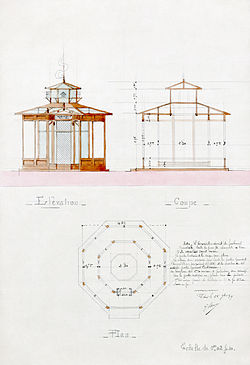Aviary
[1] Some smaller sized aviaries can often be found in European manorial gardens, such as Waddesdon Manor, UK, and Versailles, France.
An aviary, a large cage to house and display birds, dates as far back and possibly earlier than the 1500s found in the Aztec city of Tenochtitlan as noted by Hernán Cortés when he and his men arrived in 1521.
This was a recalling of the aristocratic custom from the late 1600s, which involved the elite society displaying their power, status and wealth through the exhibition of exotic birds and animals.
For instance, Baron Ferdinand de Rothschild built his aviary in 1889 at Waddesdon Manor, UK, erected in the style of Versailles' trelliswork pavilions.
It is one of only two permanent structures built for the World's Fair which still remain (the other is the Saint Louis Art Museum's Cass Gilbert building).
In 1937, the San Diego Zoo's aviary designed by architect Louis John Gill opened; it was then the largest in the world.
In diving exhibits, darters and kingfishers could be seen hunting under water, and in the free-flight hall visitors still walk amongst tropical birds in dense vegetation.
[10] In 1963, the same principle was used outdoors to construct the Bird Thicket, ten aviaries surrounded by dense bushes and designed in various habitat settings, which visitors can enter through wire netted doors and curtains of cords.
The one-way flow pattern in the exhibit moves the visitors through twenty-five birds habitats, ranging from desert to tropical forest.
Each setting recreates with impressive fidelity the microculture of the birds that fly merrily about within their diorama world, complete with living plants.


